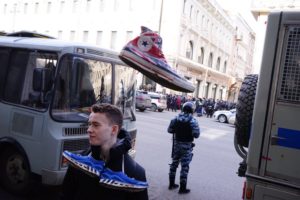By Benjamin Grove || Layout Assistant

In the past week, thousands of Russians have taken to the streets of Moscow, Russia’s capital and largest city, to rally against the corruption within the Russian government. Russia’s official news agency estimated that over eight thousand citizens were protesting the weekend of March 25 in over 100 cities across Russia. The agency also reported that the protests were declared “illegal” by Russian officials.
The goal of the protests was to confront the Russian government about the corruption of its elites. “They steal our money using their power,” said a concerned citizen in a CNN.com video. Another citizen stated that he is “against Putin” and “against his corruption.” CNN also mentioned how the protests are a response to a video that Kremlin critic Alexey Navalny posted on YouTube. The video, which centers around the corruption of Russian Prime Minister Dmitry Medvedev, has almost 16 million views. Navalny is the founder of Russia’s Anti-Corruption Foundation.
There are multiple symbols being used in the protests to show angry citizens’ disapproval. Many rioters have been carrying around rubber ducks, which relates to the claim that Prime Minister Medvedev has a duck house at one of his luxurious properties. The Anti-Corruption Foundation’s YouTube report mentions how Medvedev’s estate, known as Milowka, was previously said to be on two hectares (about 5 acres) of land by Medvedev’s account. However, the report shows that the estate occupies 80 hectares (about 198 acres). The estate evidently includes its own marina, multiple helipads, a ski slope, numerous houses, a hotel “and other buildings,” the facilities often associated with parks, and of course, the spark-igniting duck house. What would all this cost? The Anti-Corruption Foundation estimates that the property would cost anywhere from $386 to $463 million. These numbers shocked Russians, who wondered how the Prime Minister acquired the money to purchase the area. The report suggests that the money came from a foundation called Dar, using the money of shareholders in the company Novatek. Evidently, Medvedov’s wife has close ties with the foundation.
Another symbol making its way into the protest is sneakers. Medvedov has been known to show up to public events in top-of-the-line sneakers. His expensive taste has enraged Russian citizens wondering where their tax payments are going; many are questioning why the elite are living so lavishly without helping the economy or giving back to those suffering from Russia’s stagnation. Thus, some people have been bringing their old sneakers to the protests and hanging them on trees for all to see.
Transparency International, a global, non-governmental organization that advocates for transparency in the face of corruption, gave Russia a score of 29/100 on its 2016 Corruption Perceptions Index (CPI). According to Transparency International’s website, the lower-scoring countries are those with “untrustworthy and badly functioning public institutions like the police and judiciary.” Russia’s recent arrests of over 500 people—as claimed by Russian authorities; other trusted sources claim up to 1,000 in Moscow alone—at the peaceful protests around the country seem to reflect the country’s CPI score.
After almost a week of silence since the protests began, Russian President Vladimir Putin finally gave his acknowledgement and opinion of the protests. According to the New York Times, Putin accused “political forces” of using the idea of corruption, which ignites the public’s fury, “to promote their ‘self interests.’”
Whether the protests have an effect on the government or not, they are certainly something to keep an eye on as time progresses. A change may be coming to Russia.
First-year Benjamin Grove is a layout assistant. His email is bgrove@fandm.edu.